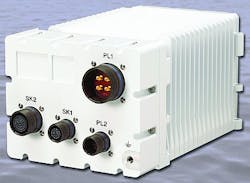Rugged computer for radar processing in UAVs and combat vehicles introduced by Curtiss-Wright
HIGH WYCOMBE, England, 5 Dec. 2012. Curtiss-Wright Controls Defense Solutions in High Wycombe, England, is shipping an enhanced version of its MPMC-9335 multi-platform mission computer (MPMC) for demanding compute-intensive applications such as image, data and radar processing in space-, weight-, and power-constrained uses such as unmanned aerial vehicles (UAVs) and ground vehicles.
The enhanced MPMC-9335 3-slot rugged VPX system supports an extended operating temperature range, with intermittent operation rated to as hot as 71 degrees Celsius and continuous operation at 65 C baseplate temperatures.
The rugged computer has the latest generation quad-core Intel Core i7 single-board computer and 240-core NVIDIA MPMC-9335 Fermi general-purpose graphics processing unit (GPGPU).
The MPMC-9335 combines the Curtiss-Wright 3U VPX VPX3-1256 quad core Intel-based single-board computer and 3U VPX VPX3-491 NVIDIA Fermi GPGPU-based compute engine in a rugged enclosure that measures 250 cubic inches.
The system's advanced thermal-management design requires no fans, vehicle supplied air, liquid, or other kinds of active cooling. The system's integrated 28 volts DC power supply unit supports DEF-STAN 61-5 Part 6, Issue 6.
The MPMC-9335's standard configuration includes two MilCAN offload controllers, a free VPX slot for a high-capacity and high-speed solid-state drive memory module, and an integrated heater to support cold-starts below -40 C.
The MPMC-9335 can be ordered as a modified commercial off the shelf product with a modified front panel connector set, modified backplane wiring, or a modified card set.
For more information contact Curtiss-Wright Controls Defense Solutions online at www.cwcdefense.com.

